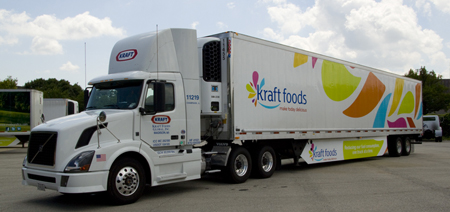Kraft Foods shared results of a pioneering survey that measured its impact on climate change, land and water use. The multi-year footprinting project—in partnership with Quantis Inc. and reviewed and analyzed by World Wildlife Fund and notable academics at the University of Minnesota Institute on the Environment—goes far beyond the company’s walls.
Photo: Kraft Foods truck
“Having the ‘big picture’ of our total footprint—from farm to fork—validates the focus of our sustainability efforts, particularly advancing sustainable agriculture,” said Roger Zellner, Sustainability Director for Research, Development & Quality. “Experts say climate change, land and water use may be among the biggest challenges in feeding a world of 9 billion people in 2050. As we continue our sustainability journey, we now have more insight into where we can make the greatest difference.”
The bulk of Kraft Foods’ environmental footprint originates on the farms that grow ingredients for the company’s products. While the company does not own farms, the survey supports the work of its sustainable agriculture efforts on key commodities to improve crop yields, reduce environmental impacts and improve the lives of many of the farm workers and their families. In addition, Kraft Foods continues to build upon previous success around energy, carbon dioxide, water, waste and packaging reductions.
This May, Kraft Foods announced expanded sustainability goals and highlighted progress against its six sustainability focus areas. The company’s new goals now include the Cadbury and LU businesses acquired since 2007. And Kraft Foods has added transportation and agricultural commodities to what it will be measuring.
From a 2010 base, by the end of 2015 Kraft Foods plans to:
• Increase sustainable sourcing of agricultural commodities by 25 percent
• Reduce energy use in manufacturing plants by 15 percent
• Reduce energy-related CO2 emissions in manufacturing plants by 15 percent
• Reduce water consumption in manufacturing plants by 15 percent
• Reduce waste at manufacturing plants by 15 percent
• Eliminate 50,000 metric tons (100 million lbs.) of packaging material
• Reduce 80 million km (50 million miles) from its transportation network
